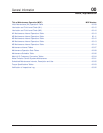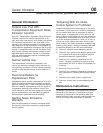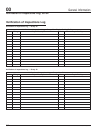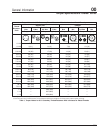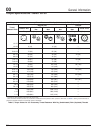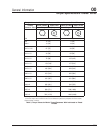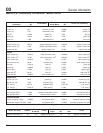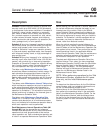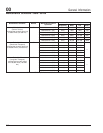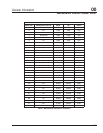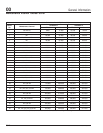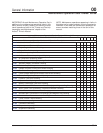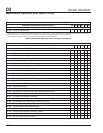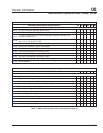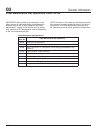
Description
Schedule I (severe service) applies to vehicles that
annually travel up to 6000 miles (10 000 kilometers)
or
that operate under severe conditions. Examples of
Schedule I usage include: operation on extremely
poor roads or where there is heavy dust accumula-
tion; constant exposure to extreme hot, cold, salt-air,
or other extreme climates; frequent short-distance
travel; construction-site operation; city operation (fire
truck, garbage truck); or farm operation.
Schedule II (short-haul transport) applies to vehicles
that annually travel
up to
60,000 miles (100 000 kilo-
meters) and operate under normal conditions. Ex-
amples of Schedule II usage are: operation primarily
in cities and densely populated areas; local transport
with infrequent freeway travel; or high percentage of
stop-and-go travel.
Schedule III (long-haul transport) is for vehicles that
annually travel
more than
60,000 miles (100 000 kilo-
meters), with minimal city or stop-and-go operation.
Examples of Schedule III usage are: regional delivery
that is mostly freeway miles; interstate transport; or
any road operation with high annual mileage.
The table under Maintenance Schedule Table
shows three different schedules of vehicle usage. For
each schedule the appropriate distance interval is
given for performing Initial Maintenance and for re-
peating each maintenance operation set (M1 through
M5). For Schedule I, the appropriate time interval is
also given.
The tables under Maintenance Interval Tables show
which maintenance operation set must be performed
at the actual distances (miles and kilometers) for
each maintenance schedule (or the actual hours of
operation for Schedule I). The schedule of actual dis-
tances (and hours) is based on the intervals given in
the Maintenance Schedule Table.
The tables under Maintenance Operation Sets
Tables list, in numerical order, the text reference
numbers and descriptions of
all
maintenance opera-
tions, and indicates all maintenance operation sets at
which each operation must be performed.
Each Maintenance Interval Operations Table (IM
through M5) lists the appropriate text reference
numbers and descriptions of only those maintenance
operations that must be performed at that mainte-
nance operation set. Each maintenance operation set
is listed in a separate Maintenance Operations Table.
Use
Before placing your new vehicle in service, determine
the correct maintenance intervals that apply to your
intended use of the vehicle. Refer to the Mainte-
nance Schedule Table to determine the distance (or
hour) interval at which each Maintenance Operation
Set must be performed to comply with your vehicle’s
schedule. For Schedule I vehicles equipped with an
hourmeter, use hours to determine maintenance in-
tervals, rather than distance traveled.
When the vehicle reaches the actual distance (or
hours) given for an interval, refer to the Maintenance
Interval Tables to find the Maintenance Operation Set
that applies to that interval. Then perform the mainte-
nance operations listed in the applicable Mainte-
nance Interval Operation Table. Use the maintenance
operation reference numbers to find instructions in
the manualfor completion of each operation.
Complete each Maintenance Operation Set at the
required interval. Then, when you have completed
Maintenance Operation Set M5 under the 32nd Main-
tenance Number listed in the Maintenance Interval
Table, repeat the pattern. The 33rd Maintenance
Number will begin at Maintenance Operation Set M1,
under the 1st Maintenance Number listed in the
Maintenance Interval Table.
NOTE: When performing operations for the 33rd
Maintenance Number, complete the M1 opera-
tions only, not the Initial Maintenance opera-
tions.
To determine the distance/hours for the 33rd Mainte-
nance Number, add your schedule’s distance/hours
for the 1st Maintenance Number to the
distance/hours for the 32nd Maintenance Number,
then perform the operations listed in the applicable
table in the Maintenance Operations Tables. For the
34th Maintenance Number, add the distance/hours
for the 2nd to the distance/hours for the 32nd; con-
tinue this pattern for each successive Maintenance
Number.
General Information 00
Scheduled Maintenance Intervals, Description and
Use: 00–05
Acterra Maintenance Manual, January 2007 00/7




